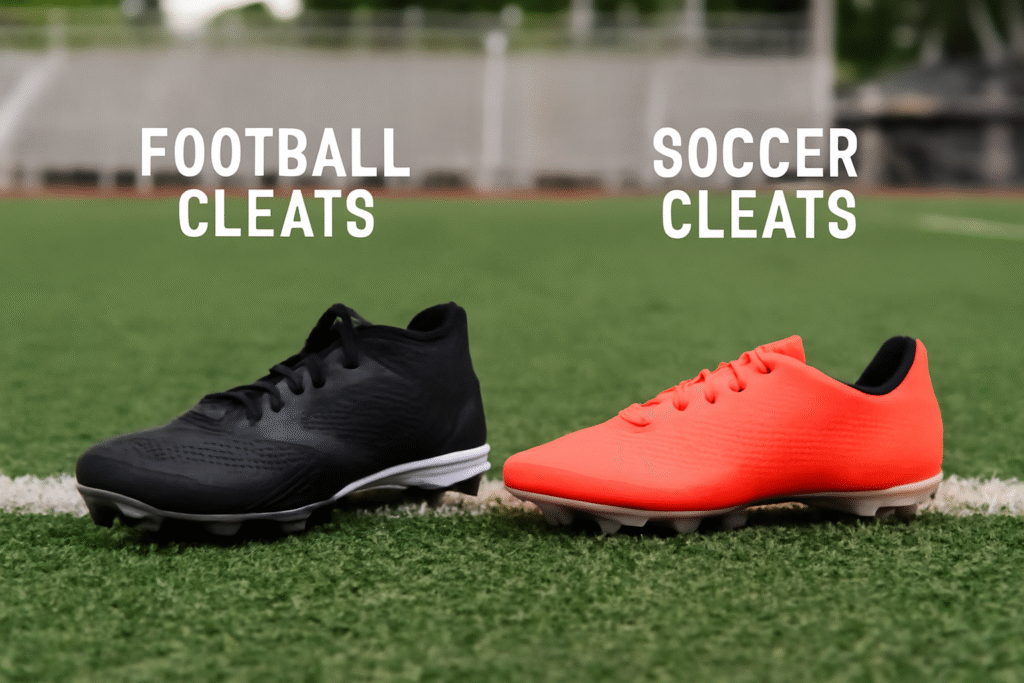Introduction
Whether you’re new to the sport or just checking your gear options, a common question arises: can you use football cleats for soccer? On the surface, both cleats look similar—rubber or metal studs, lace-up design, and performance-based structure. But don’t be fooled.
In this article, we’ll break down the similarities and crucial differences between football cleats and soccer cleats, their impact on performance and safety, and when (if ever) you can use one for the other.
⚽ What’s the Difference Between Soccer and Football Cleats?
At a glance, cleats for both sports may seem interchangeable, but design purposes vary greatly.
1. Toe Stud Design
Football cleats often feature a toe stud at the front to help players dig into the turf for powerful pushes.
Soccer cleats do not have this front stud to prevent injury during tackles and ball control.
2. Weight and Flexibility
Football cleats are bulkier, providing protection for tackles and short sprints.
Soccer cleats are lightweight, promoting speed, agility, and continuous motion.
3. Ankle Support
Football players might wear mid or high-top cleats for extra ankle support.
Soccer demands full ankle mobility, so cleats are always low-cut.
4. Stud Pattern and Traction
Soccer cleats have even stud distribution for turning, sprinting, and dribbling.
Football cleats have position-specific stud configurations (e.g., linemen vs. receivers), often not ideal for soccer fields.
Is It Safe to Use Football Cleats for Soccer?
Safety is a big concern when mixing gear.
Risks of Using Football Cleats for Soccer:
Increased Injury Risk: The front toe stud can catch the ground or a player’s leg, causing dangerous tackles or ankle sprains.
Referee Disqualification: Many soccer leagues don’t allow football cleats due to their toe spike.
Performance Drop: The weight and stiffness of football cleats can hinder your speed, control, and accuracy in soccer.
So while you can wear football cleats casually, you shouldn’t use them for competitive soccer.
When Can You Use Football Cleats for Soccer?
There are only a few scenarios where using football cleats for soccer might be acceptable:
Backyard games or practice sessions
Tight budget situations, especially for kids just trying the sport
Training in multi-purpose shoes, knowing you’re sacrificing some performance
But again, it’s better to invest in proper gear if you’re planning to play regularly or join a team.
👟 What Makes Soccer Cleats Better for the Game?
If you’re serious about soccer, investing in proper soccer cleats is essential. Here’s why:
✅ Improved Ball Control
Soccer cleats are built for touch sensitivity, allowing precise dribbling and shooting.
✅ Lighter Build
Less weight means faster turns, quicker sprints, and more stamina.
✅ Safety Compliance
Soccer cleats meet league standards and keep you within the rules.
Football vs. Soccer Cleats Comparison Table
| Feature | Football Cleats | Soccer Cleats |
|---|---|---|
| Toe Stud | Yes (can be dangerous) | No |
| Weight | Heavier | Lightweight |
| Ankle Support | Mid/High Tops Available | Always Low-Cut |
| Flexibility | Stiff for contact | Flexible for control |
| Use in Soccer Leagues | Often Prohibited | Fully Approved |
Buying Guide: How to Choose the Right Soccer Cleats
Ready to switch? Here are a few tips to get the best soccer cleats:
Know Your Surface: Choose between firm ground (FG), soft ground (SG), turf (TF), or indoor (IN) cleats.
Check Fit: Cleats should be snug but not tight—avoid blisters and lost toenails!
Material: Synthetic for budget and water resistance, leather for feel and comfort.
Budget: Good cleats can start around $30–$50 for beginners and go over $150 for pros.
Expert Opinion
“While football cleats offer strong grip and protection, they’re simply not built for the dynamics of soccer. Using them regularly increases your risk of injury and weakens your game mechanics.”
— Coach Ray Adams, Youth Soccer League Official
Final Verdict: Can You Use Football Cleats for Soccer?
Technically yes, but practically no—not if you care about safety, performance, and staying within the rules.
Football cleats may work in a pinch or casual setting, but for real matches and progress in soccer, always go with the right gear.
Frequently Asked Questions
1. Can my child use football cleats for soccer practice?
Yes, but only for backyard or casual practice. Most youth leagues won’t allow them during games.
2. Are soccer cleats more expensive than football cleats?
Prices vary, but generally, entry-level soccer cleats are similarly priced or cheaper.
3. Can I remove the toe stud from football cleats to make them soccer-safe?
Not advisable. It alters shoe balance and doesn’t guarantee safety approval.
4. Do all football cleats have a toe stud?
Most do, especially lineman or all-purpose cleats. Some skill-position cleats might not.
5. Is it better to just buy multi-sport cleats?
If you play both sports casually, yes. But for competitive play, invest in sport-specific cleats.

